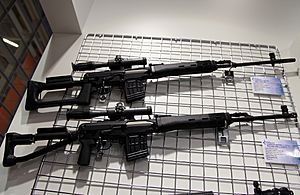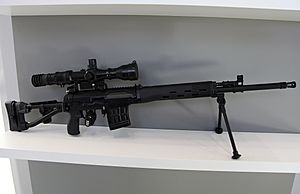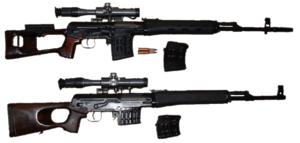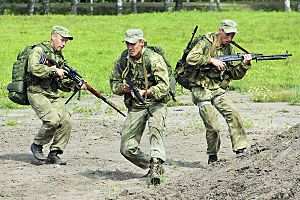SVD (rifle) facts for kids
Quick facts for kids SVD |
|
|---|---|
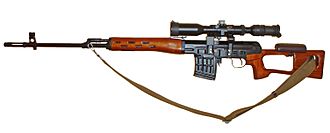
SVD with a wooden handguard/gas tube cover and skeletonized stock used before the change to synthetic black furniture
|
|
| Type | Designated marksman rifle Sniper rifle |
| Place of origin | Soviet Union |
| Service history | |
| In service | 1963–present |
| Used by | See Users |
| Wars | See Conflicts |
| Production history | |
| Designer | Yevgeny Dragunov |
| Designed | 1958–1963 |
| Manufacturer |
|
| Produced | 1963–present |
| Variants | See Variants |
| Specifications | |
| Mass |
|
| Length |
|
| Barrel length |
|
|
|
|
| Cartridge | 7.62×54mmR |
| Action | Gas-operated, rotating bolt |
| Rate of fire | Semi-automatic |
| Muzzle velocity |
|
| Effective firing range | 800 m (875 yd) |
| Feed system | 10-round detachable box magazine |
| Sights | PSO-1 telescopic sight, 1PN51/1PN58 night vision sights and iron sights with an adjustable rear notch sight |
The SVD (which stands for Snayperskaya Vintovka Dragunova, meaning "Dragunov Sniper Rifle") is a special type of semi-automatic rifle. It was created in the Soviet Union and uses a powerful 7.62×54mmR cartridge.
The SVD was designed to help soldiers in a squad hit targets accurately from far away. This was important because other standard rifles used by the Warsaw Pact (an alliance of Eastern European countries) had a shorter range. Meanwhile, NATO (an alliance of Western countries) used rifles that could shoot further.
The rifle was developed between 1958 and 1963 by a team led by Yevgeny Dragunov. After many tests, Dragunov's design was chosen in 1963. Production started in 1964 by Izhmash, now known as Kalashnikov Concern.
Since then, the SVD has become a common support weapon for many countries, especially those that were part of the former Warsaw Pact. Countries like China and Iran have also made their own versions of the SVD.
Contents
How the SVD Rifle Works
The SVD looks a bit like the famous AK rifles, but it works differently. These similarities are mostly for ease of use by soldiers.
Inside the SVD: Operating System
The SVD uses a system where gas from a fired bullet helps reload the next one. This is called a gas-operated system. It has a special part called a rotating bolt that locks the bullet safely in place before firing.
The rifle is designed to fire one shot at a time when the trigger is pulled (semi-automatic). It uses a 10-round magazine, which holds the bullets in a zigzag pattern. When the last bullet is fired, the rifle's action stays open, making it easy to reload.
The main body of the rifle, called the receiver, is carefully made to be very strong and help with accuracy.
The Barrel: Where the Bullet Travels
The SVD's barrel is thin to keep the rifle light. The inside of the barrel is coated with chrome. This helps protect it from rust and makes it last longer.
The barrel has special grooves inside that make the bullet spin as it travels. This spin helps the bullet fly straight. Over time, the way these grooves were made changed to allow the rifle to use different types of ammunition more effectively.
At the front of the barrel, there are basic iron sights and a place to attach a bayonet. There's also a special part called a flash hider that reduces the bright flash when the rifle is fired.
Ammunition for the SVD
To make the SVD very accurate, a special "sniper" bullet was created in 1966. This bullet was designed to fly very straight and hit targets precisely.
Later, in 1999, this special bullet was updated. The new version had a harder steel tip. This change was made because soldiers started wearing better body armor, and the new bullet could go through it more easily.
Sights: Helping You Aim
The SVD has two main types of sights:
- Iron Sights: These are simple sights on the rifle itself. They can be adjusted for targets from 100 to 1,200 m (109 to 1,312 yd). You can use them even if the optical sight is attached.
- Telescopic Sight (PSO-1): This is a special scope that magnifies the target, making it look closer. It attaches to the left side of the rifle. The PSO-1 helps shooters hit targets accurately from 100 metres (109 yd) up to 1,000 metres (1,094 yd). It also has special markings to help estimate distance and adjust for wind.
Some SVD rifles, called SVDN variants, come with special night vision sights. These sights help soldiers see targets in the dark.
Stock and Handguard
The original SVD rifles had parts made from birch plywood. This included the handguard (where you hold the front of the rifle) and the stock (the part that rests against your shoulder). The stock had a special shape with a thumbhole and a removable cheek rest.
In the 1980s, these wooden parts were replaced with black polymer (a type of plastic). The new parts looked similar but were more durable.
Accessories for the SVD
The SVD comes with several useful accessories:
- A bayonet, which is a knife that can be attached to the end of the rifle.
- Extra magazines to hold more bullets.
- A sling for carrying the rifle.
- A cleaning kit to keep the rifle in good condition.
- A maintenance kit for the telescopic sight.
There's also a special bipod that can be attached to the front of the rifle. It has two adjustable legs that fold up. This bipod helps the shooter steady the rifle for more accurate shots.
SVD Rifle Versions
Over the years, many different versions and prototypes of the SVD have been made.
- SVDN: These are SVD rifles that come with different night vision sights.
- SVDS: This version was made shorter for soldiers like marines and paratroopers. It has a folding stock and a shorter barrel. This makes it easier to carry and use in tight spaces.
- SVDM: A newer, updated version of the SVDS, introduced in 2018. It has a thicker barrel, new parts, and a special rail to attach modern scopes. It can also use a detachable bipod and a sound suppressor.
- OTs-03 SVU: A shorter version of the SVD that started production in 1991. It has an improved muzzle brake and different rear sights. Some were even made to fire automatically, but this feature was later removed.
Experimental Prototypes
Several experimental versions of the SVD were developed:
- SSV-58: An early design by Dragunov that was slightly different from the final SVD.
- TKB-0172: An early "bullpup" design, where the action is behind the trigger, making the rifle shorter.
- V-70 and AF: Prototypes designed to fire automatically, with larger magazines.
- SVDG and SSV-6: Experimental versions that used different, unusual types of ammunition.
- SVDK: An experimental Russian version that uses a very powerful 9.3×64mm cartridge.
Civilian and Foreign Versions
- Tigr: This is a civilian version of the SVD, made for hunting and sport. It doesn't have a bayonet lug. It comes in different barrel lengths and can use various types of ammunition.
- SWD-M: A modernized Polish version of the SVD, with a heavier barrel and a different scope.
- Al-Kadesih: An Iraqi version that looks like the SVD but has some unique differences, so parts are not interchangeable.
- Type 79/85: Chinese copies of the SVD. They are very similar but also have slight differences in size. Some were made for export.
- CS/LR19 or NSG-85: A modernized Chinese version of the Type 85.
Role of the SVD in Combat
The SVD was used by designated marksmen in the Soviet Army. These marksmen were special soldiers who could shoot very accurately. The SVD was designed to be lighter than traditional sniper rifles, making it easier for these soldiers to move with their units.
The idea was that a few marksmen with SVDs could help regular troops. They could target important enemy positions or individuals, like officers, radio operators, or machine gun teams, from much longer distances and with greater accuracy.
Many countries that were part of the Warsaw Pact had at least one SVD marksman in each infantry platoon. These marksmen were often chosen from soldiers who were already excellent shooters. They were trained to hit a standing person-sized target from 800 m (875 yd) about half the time, and from 500 m (547 yd) about 80% of the time. For closer targets (under 200 m (219 yd)), their accuracy was even higher.
Who Uses the SVD?

 Afghanistan
Afghanistan Algeria
Algeria Albania
Albania Austria
Austria Bangladesh: Uses Chinese Type 85 version.
Bangladesh: Uses Chinese Type 85 version. Belarus
Belarus Bolivia: Uses Type 79 version.
Bolivia: Uses Type 79 version. Burundi
Burundi Bulgaria
Bulgaria Central African Republic
Central African Republic China: Makes its own copies, the Type 79 and Type 85.
China: Makes its own copies, the Type 79 and Type 85. Czech Republic: Mostly in reserve units now.
Czech Republic: Mostly in reserve units now. Egypt
Egypt Finland: Called the 7.62 TKIV Dragunov.
Finland: Called the 7.62 TKIV Dragunov. Georgia
Georgia Hungary
Hungary India: Being replaced by newer rifles.
India: Being replaced by newer rifles. Iran: Makes its own version called Nakhjir 3 Sniper Rifle.
Iran: Makes its own version called Nakhjir 3 Sniper Rifle. Iraq: Uses Al Kadesiah and SVD rifles.
Iraq: Uses Al Kadesiah and SVD rifles. Ivory Coast
Ivory Coast Islamic State
Islamic State Kazakhstan
Kazakhstan Kyrgyzstan
Kyrgyzstan Latvia
Latvia Lesotho
Lesotho Libya
Libya Lord Resistance Army
Lord Resistance Army Mali
Mali Moldova
Moldova Nicaragua
Nicaragua Niger
Niger North Korea
North Korea Panama: Formerly used.
Panama: Formerly used. Philippines: Uses Chinese Type 85 and SVDs from Russia.
Philippines: Uses Chinese Type 85 and SVDs from Russia. Poland: Uses a modernized version called SWD-M.
Poland: Uses a modernized version called SWD-M. Russia: Uses SVD-M and SVDS versions.
Russia: Uses SVD-M and SVDS versions. Senegal
Senegal Serbia
Serbia Slovakia
Slovakia Sudan
Sudan Syria
Syria Tajikistan
Tajikistan Turkey
Turkey Turkmenistan
Turkmenistan Ukraine
Ukraine Uzbekistan
Uzbekistan Venezuela
Venezuela Vietnam
Vietnam Zimbabwe
Zimbabwe
Past Users
 East Germany
East Germany Chechen Republic of Ichkeria
Chechen Republic of Ichkeria Czechoslovakia
Czechoslovakia Soviet Union
Soviet Union
Conflicts Where the SVD Was Used
The SVD has been used in many conflicts around the world since it was introduced.
- Vietnam War
- Sino-Vietnamese War
- Soviet–Afghan War
- Lebanese Civil War
- Iran–Iraq War
- First Nagorno-Karabakh War
- Gulf War
- Salvadoran Civil War
- Operation Restore Hope
- South African Border War
- Burundian Civil War
- War in Afghanistan (2001–2021)
- Iraq War
- Yugoslav Wars
- First Chechen War
- Second Chechen War
- 2011 Libyan Civil War
- Northern Mali conflict
- Syrian Civil War
- Boko Haram insurgency
- Iraqi Civil War (2014–2017)
- Russo-Ukrainian War
- Yemeni Civil War (2015–present)
- Saudi–Yemeni border conflict (2015–present)
- 2022 Russia-Ukraine war
More About Similar Rifles
 In Spanish: Fusil de francotirador Dragunov para niños
In Spanish: Fusil de francotirador Dragunov para niños
- SVDK: A version of the SVD that uses a different, larger bullet.
- VSS Vintorez: Another Russian sniper rifle, but it's designed to be very quiet.
- Puşca Semiautomată cu Lunetă (PSL): A Romanian rifle that looks similar to the SVD.
- Zastava M76: A rifle from Yugoslavia that also looks like the SVD.
- Zastava M91: A Serbian rifle that resembles the SVD.
- IMI Galatz: An Israeli rifle that looks similar to the SVD.




